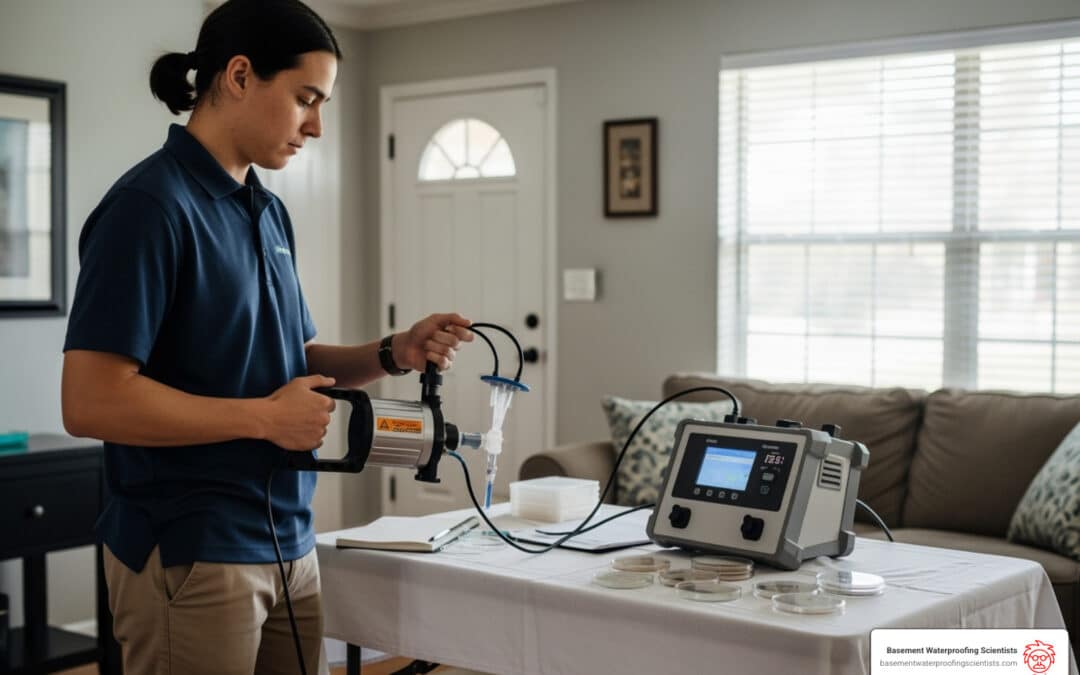Why Post-Remediation Testing is Your Final Defense Against Mold
Mold testing after remediation is the critical final step that confirms your home is truly safe for occupancy after mold removal work is complete. This verification process, also known as clearance testing, involves air and surface sampling to ensure mold spore levels have returned to normal, healthy ranges.
Key components of post-remediation testing:
- Visual inspection – Confirms no visible mold, dust, or debris remains
- Air sampling – Measures airborne spore concentrations using specialized equipment
- Surface sampling – Tests specific areas for remaining contamination
- Laboratory analysis – Identifies mold types and quantifies spore levels
- Comparison to outdoor levels – Ensures indoor air quality matches normal outdoor fungal ecology
- Independent verification – Third-party testing eliminates conflict of interest
The stakes couldn’t be higher. As one industry expert noted, “If you are asking about clearance testing after the work has been completed, there’s a good chance it wasn’t done correctly.” Without proper verification, you risk exposing your family to health hazards and facing costly re-remediation down the road.
Why clearance testing matters:
- Protects your family’s health from lingering mold spores
- Verifies remediation contractor’s work was effective
- Provides legal documentation for insurance claims
- Prevents expensive future mold problems
- Ensures compliance with industry standards like IICRC S520
I’m Darin Garvey. With over 30 years in basement waterproofing and moisture control, I’ve seen how critical mold testing after remediation is for protecting homes and families. My team at Basement Waterproofing Scientists has helped countless homeowners ensure their homes are truly mold-free after remediation.
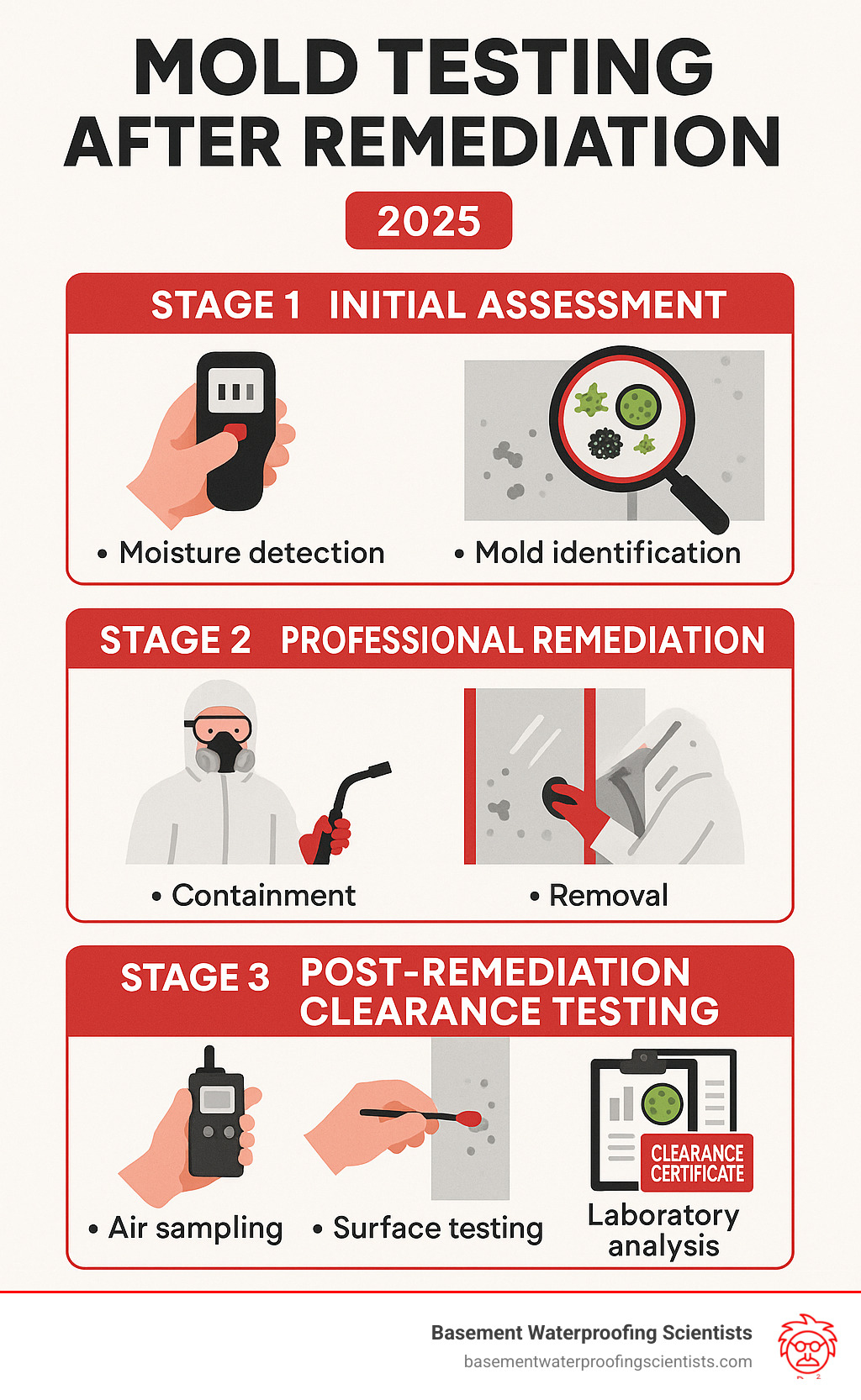
Mold testing after remediation terminology:
What is Post-Remediation Verification and Why is it Crucial?
Post-remediation verification, or a “clearance test,” is a vital safeguard, not just a formality. After mold removal, this step provides objective proof that the remediation was successful and your home is safe to re-occupy. Without this critical step, you’re hoping the mold is gone, rather than knowing for sure.
This verification process serves multiple crucial purposes:
- Verifying Success: It objectively confirms that our remediation efforts have successfully brought mold spore levels back to a “normal fungal ecology.”
- Health Protection: It protects your family from potential health implications associated with lingering mold spores, which can still cause allergic reactions or respiratory issues.
- Property Value: It helps maintain your property’s value by providing documented proof that a mold issue has been professionally addressed and resolved.
- Insurance Requirements: Many insurance companies require a passed clearance test as part of the claim process to ensure the remediation was effective.
- Legal Documentation: A clearance report provides legal documentation of the successful remediation, which can be invaluable for future property sales or disputes.
- Preventing Recurrence: By confirming the absence of mold and often checking that moisture sources have been addressed, it significantly reduces the likelihood of mold returning.
We understand that dealing with a wet basement and the subsequent mold can be stressful. That’s why we emphasize the importance of post-remediation verification. It’s our way of ensuring your peace of mind. For more insights into how wet basements can create mold, check out our detailed guide: More info about how wet basements create mold.
The Health Risks of Skipping a Final Test
Ignoring mold testing after remediation can have serious health consequences. Even after visible mold is removed, microscopic mold spores can remain airborne or settled on surfaces. These “dead mold” spores can still be released into the air and trigger a range of health issues. Think of it this way: even if a bee is dead, its sting can still hurt if you step on it!
Exposure to these lingering spores can lead to:
- Allergic reactions: Persistent sneezing, runny nose, itchy eyes, skin rashes.
- Respiratory issues: Coughing, wheezing, shortness of breath, and phlegm build-up.
- Asthma triggers: For individuals with asthma, mold spores can significantly worsen symptoms.
- Mycotoxins: Some molds produce mycotoxins, which can travel with spores and potentially lead to more severe health problems, though this is less common.
Vulnerable individuals, such as infants, children, seniors, pregnant people, and those with pre-existing respiratory conditions or compromised immune systems, are particularly susceptible to these health effects. We believe strongly that no family should have to worry about these risks in their own home. For a deeper dive into the health implications, Health Canada provides valuable information on the Health effects of dampness and mould exposure.
The Importance of Independent, Third-Party Testing
For mold testing after remediation, independent, third-party testing is crucial because it eliminates any potential conflict of interest. As one expert put it, “It’s always essential to have the testing done by a company that is not associated with the mold remediation company doing the work so that there isn’t any conflict of interest.” This is like not letting a chef grade their own cooking; you want an unbiased opinion.
An independent certified air quality professional provides an objective and impartial assessment of the remediation work. This unbiased evaluation ensures that the results are trustworthy and credible. When you’re dealing with something as important as your family’s health and home, you want results you can absolutely rely on.
We recommend looking for inspectors with reputable certifications, such as those from IAC2 certification or similar credentialing bodies. These certifications indicate that the professional has met rigorous industry standards for knowledge and practice. This objective approach is key to ensuring contractor accountability and confirming that the remediation work was not just done, but done right.
The Step-by-Step Process for Mold Testing After Remediation
When conducting mold testing after remediation, we follow a meticulous, step-by-step process adhering to industry protocols. This is a detailed investigation, not a quick glance. We ensure the area is under specific pre-test conditions, usually within the original containment, before collecting any samples.
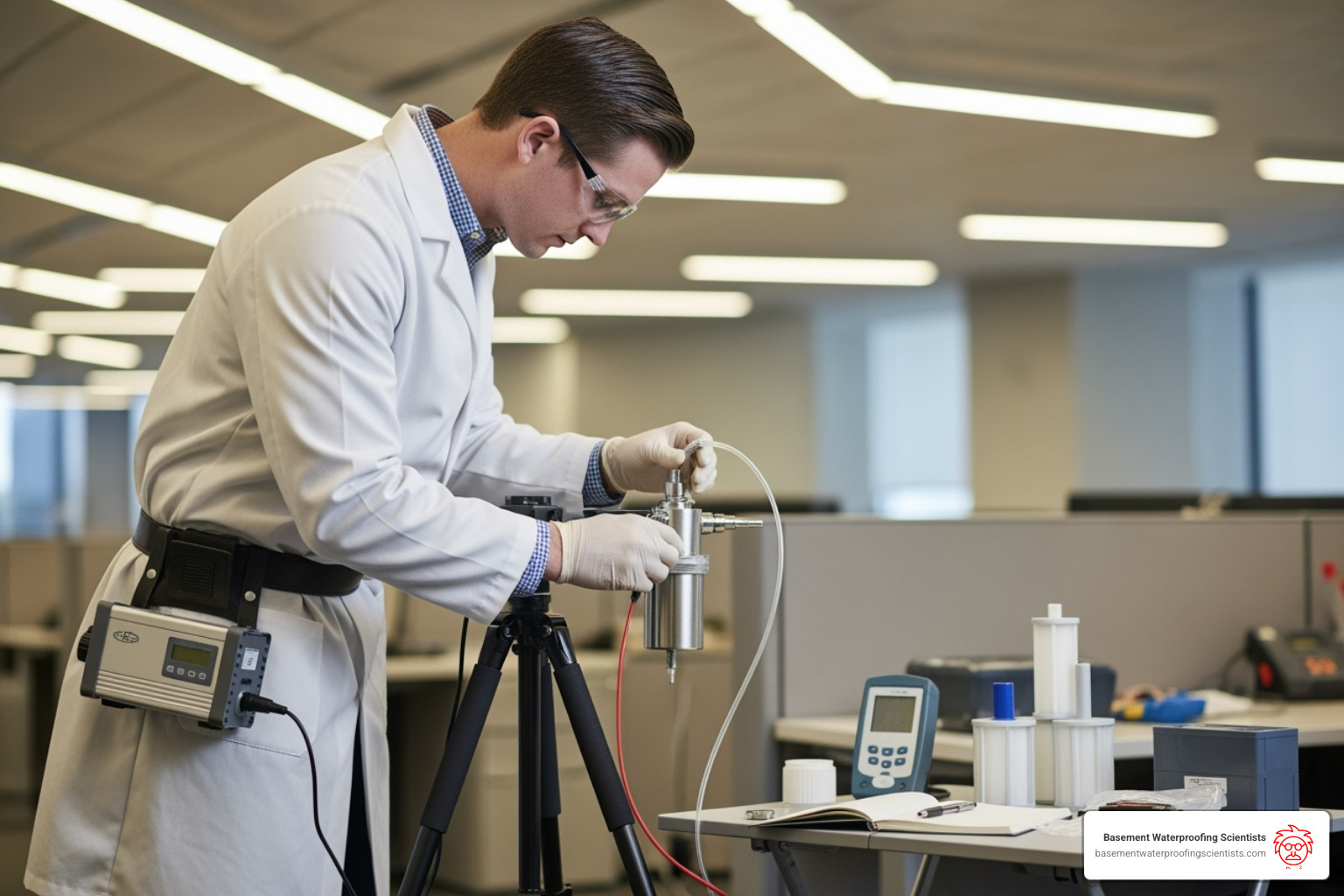
The Critical Role of Visual Inspection
The first, and arguably most fundamental, component of post-remediation verification is a thorough visual inspection. Even before any fancy equipment comes out, our eyes are our primary tools. We’re looking for any visible signs of mold growth, no matter how small. If visible mold can still be seen on drywall, it needs to be cut out and properly disposed of – there’s no two ways about it.
Beyond visible mold, we carefully check for any dust or debris. Mold spores are part of normal dust, so if there’s a lot of dust in the area remediated, you can expect to find many spores. We often employ what we call the “white glove test.” If you can move your finger across a surface in the area of containment and pick up dirt or dust, this would likely be a ‘fail’ in our view.
We also use moisture meters to confirm that the remediated area is completely dry, because if you find moisture of any sort in the area being remediated, that is a definite fail. We’re also attuned to any lingering musty odors, which can indicate hidden mold growth. This visual confirmation ensures that the physical removal of mold and proper cleaning have been thoroughly completed. For more information on how we check for mold, you can visit: More info on how to check for mold in your house.
Air vs. Surface Sampling: What’s the Difference?
After the visual inspection, we move on to collecting samples. The two primary methods for collecting mold samples are air sampling and surface sampling. Each provides different, yet complementary, pieces of information about the success of the remediation.
| Feature | Air Sampling | Surface Sampling |
|---|---|---|
| Method | Spore trap, impaction, or filtration | Swab, tape lift, or contact plate |
| What it measures | Airborne mold spore concentration | Mold growth or settled spores on a surface |
| Primary purpose | Assesses indoor air quality and potential inhalation risk | Identifies remaining contamination or effectiveness of surface cleaning |
| Key comparison | Indoor levels compared to outdoor levels | Presence/absence of mold, specific species on surfaces |
| Limitations | Snapshot in time, influenced by air currents | Only tests specific spots, may not reflect overall air quality |
Air sampling, for example, uses specialized equipment like air pumps and cassettes to collect air samples and determine the concentration of mold spores present in the indoor environment. This helps us see if the air you breathe is clear.
Surface sampling involves collecting samples from various surfaces using swabs, tape lifts, or contact plates. This method helps us identify any remaining mold growth or settled spores that might not be airborne but are still present in the environment.
Both types of samples are then sent to an accredited laboratory for detailed analysis. While some homeowners might consider DIY options, we always recommend professional testing for accurate and reliable results. For more information on DIY mold air tests, you can refer to our insights here: More info on DIY mold air tests.
The Role of Laboratory Analysis
Once the air and surface samples are collected, they are sent to an accredited laboratory for analysis. This is where the real science happens! Lab professionals, often industrial hygienists, carefully examine the samples under microscopes and perform advanced tests to:
- Spore Identification: Identify the specific types of mold spores present in the samples. Knowing the species can be crucial, as some molds, like Stachybotrys (often called “black mold”), are considered more harmful than others.
- Spore Quantification: Quantify the number of mold spores found. This provides a numerical value that can be compared against established guidelines and outdoor control samples.
- Fungal Ecology: Provide insights into the overall fungal ecology of the indoor environment, helping to determine if it has returned to a normal state.
The lab then generates a detailed report summarizing their findings. This report is the backbone of our clearance decision. It provides the objective data needed to determine if the remediation was successful and if your home is truly mold-free. For more information on what we look for when testing for specific types of mold, like black mold, you can visit: More info on black mold testing.
Understanding Your Clearance Test Results
Receiving your mold testing after remediation report can feel like reading a secret code, but we’re here to translate it. This report details the types and quantities of mold spores found in your home’s samples. Our goal is to see if your home has returned to a “normal fungal ecology”—a healthy, balanced state, just like nature intended.
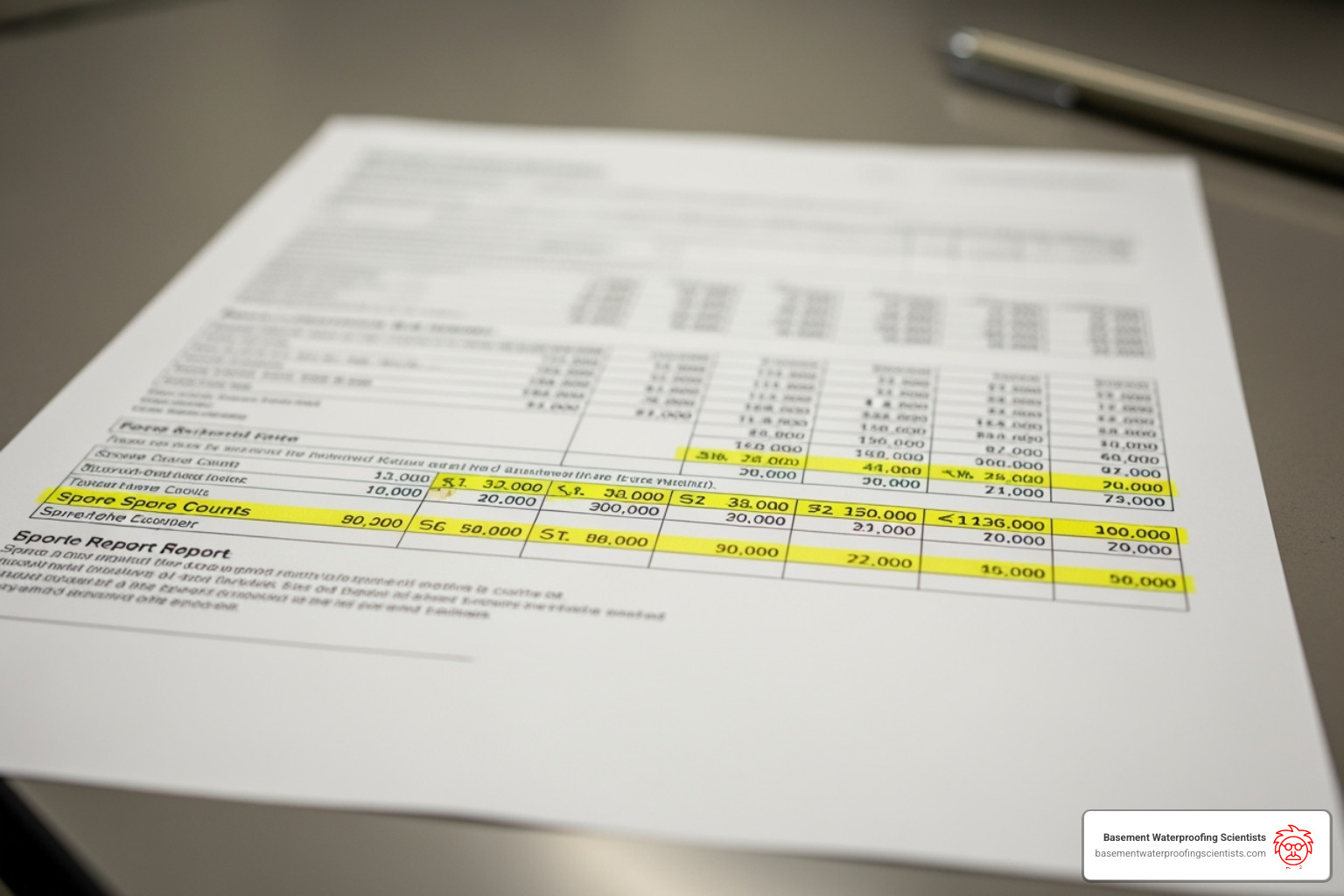
To figure this out, we carefully compare the mold spore counts from inside your home to what’s normally found outdoors. We also look closely at the specific kinds of mold we find and check how truly clean the remediated area is. All of this helps us make the final “Pass” or “Fail” decision for your home.
What are the Industry Standards for a “Pass”?
So, what does it take to earn that coveted “Pass” on a clearance test? The gold standard in our industry, especially the IICRC S520 Standard for Mold Remediation, tells us that the mold spore levels inside your home should be very similar to those outside. That’s why we often take an outdoor air sample as a “control” – it’s our natural baseline.
Generally, for a “Pass,” we look for indoor mold counts to be quite low, often below 1,000 spores per cubic meter of air. But it’s not just about the total number; the types of mold matter too. For certain “indicator” mold species, like Aspergillus and Penicillium, we want to see levels typically below 200 spores per cubic meter. The main takeaway is that your home should show absolutely no sign of active mold growth, and the types and amounts of spores should match what’s floating around naturally outdoors, not hidden contamination from inside. For all the nitty-gritty details on these guidelines, you can peek at the IICRC S520 Standard guidelines.
Common Reasons for a Failed Clearance Test
It can be a real bummer if your home doesn’t pass its post-remediation inspection, but please know, it’s not the end of the world! There are a few common reasons why a home might fail its mold testing after remediation:
First off, a big one is when the underlying moisture source isn’t truly fixed. Mold just loves moisture and can start growing again in as little as 48 hours if water or high humidity hangs around. As we always say, “if you find moisture of any sort in the area being remediated, that is a definite fail.”
Another reason is incomplete physical removal. Just killing mold isn’t enough; dead mold spores can still cause allergic reactions if they’re left behind. If you can still see mold on drywall, even a tiny bit, it needs to be cut out and properly removed – no shortcuts there!
Then there’s the issue of cross-contamination. Mold spores are super tiny and can easily spread to other parts of your home if the remediation team didn’t set up proper containment barriers or keep negative air pressure during the work.
Inadequate cleaning is also a frequent culprit. Even after the mold itself is gone, microscopic spores and dust can linger. If you can move your finger across a surface in the area of containment and pick up dirt or dust, this would likely be a ‘fail’ in our view. That’s why a super thorough cleaning, sometimes called the “white glove test,” is so incredibly important.
Finally, insufficient air scrubbing can lead to a fail. Air scrubbers are like superheroes for cleaning airborne spores, but they need to run long enough and be handled correctly. If they’re turned off too soon or not used properly, those pesky spores can just float right back into the air.
What to Do After a Failed Mold Testing After Remediation
So, what happens if your home fails its mold testing after remediation? The good news is, it’s not a dead end! If your home doesn’t pass, we simply need to take some corrective steps to fix whatever caused the failure.
First, we’ll carefully go over the detailed clearance report together. This helps us pinpoint exactly why the test failed – maybe it was a missed moisture source, an area where mold wasn’t fully removed, or signs of cross-contamination.
Next, we’ll reconnect with the remediation contractor. Based on what the report tells us, they’ll need to do some additional work. This could mean more cleaning, re-establishing the containment area, or even making more structural repairs to truly solve that root moisture problem. Once these fixes are done, the area will need to be re-tested to make sure it finally meets those important clearance criteria. We know this can feel like an extra hurdle, but it’s a crucial step to guarantee your home is truly safe and healthy for your family. For more on why keeping moisture in check is so vital for preventing mold from coming back, check out our guide: More info on why controlling moisture is key.
Maintaining a Mold-Free Home Post-Remediation
Passing your mold testing after remediation is a great achievement, but the work isn’t over. Maintaining a mold-free home requires a long-term strategy of vigilance, moisture control, and ventilation. A little regular maintenance goes a long way.
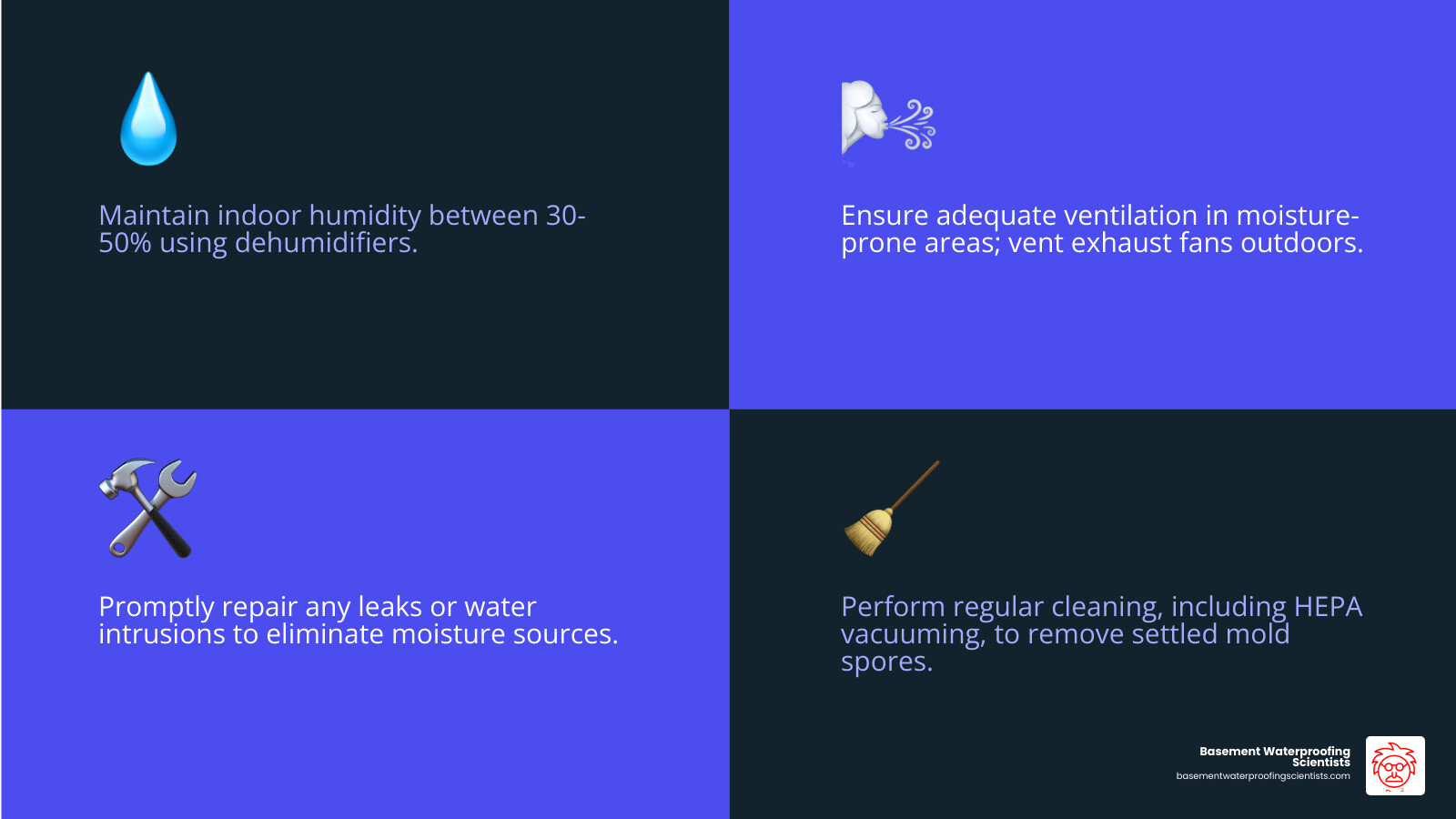
Best Practices for Long-Term Mold Prevention
At Basement Waterproofing Scientists, our goal is to help you maintain a healthy, dry environment long-term. Here are our best practices for mold prevention:
- Humidity Control (30-50%): Mold thrives in moist environments. We recommend keeping your indoor relative humidity levels between 30% and 50%. This can be achieved with properly sized dehumidifiers, especially in basements and crawl spaces.
- Proper Ventilation: Ensure adequate airflow throughout your home, particularly in moisture-prone areas like bathrooms, kitchens, and basements. Exhaust fans should vent outside, not into attics or wall cavities.
- Prompt Leak Repair: Any water leak, no matter how small, can become a breeding ground for mold within 48 hours. Fix leaky pipes, roofs, or foundation cracks immediately. Our specialized equipment helps us identify leak sources to fix leaks for less, ensuring a permanently dry basement.
- Regular Inspections: Periodically check your basement, crawl space, and other damp areas for signs of moisture or new mold growth. Early detection is key!
- HEPA Vacuuming: Regular cleaning with a HEPA-filter vacuum can help remove lingering mold spores and dust, which can serve as a food source for mold.
- Improving Basement Air Quality: Given our expertise in basement waterproofing, we know basements are often ground zero for moisture issues. Addressing these directly improves overall air quality throughout your home. For more tips on this, check out: More info on basement air quality improvement.
We serve homeowners across Pennsylvania, New Jersey, and Delaware, including areas like Philadelphia, Reading, Norristown, Pottstown, Bensalem Township, and many more. Our 30 years of experience have taught us that proactive moisture management is the best defense against mold.
Frequently Asked Questions about Post-Remediation Testing
You’ve probably got some questions buzzing around your head about mold, especially after going through a remediation process. That’s perfectly normal! We’re here to clear things up and give you peace of mind. Here are some of the most common questions we hear about mold testing after remediation.
What is the difference between mold remediation and mold testing?
Understanding this difference is key to a truly mold-free home! Think of it like this:
Mold remediation is the hands-on work. It’s the physical process of actually removing and thoroughly cleaning mold growth from your home. This involves containing the affected area, safely removing contaminated materials, and performing specialized cleaning to get rid of every last trace of mold. Often, it also includes addressing the water source that caused the mold in the first place. You can think of remediation as the “fix” part of the problem – it’s where the mold gets shown the door!
On the other hand, mold testing is the scientific detective work. It’s the process of taking samples from your environment – both from the air and from surfaces – and analyzing them to figure out exactly what kind of mold is present, and how much of it there is. Testing is typically done before any remediation work begins, to help us understand the scope of the problem. And most importantly, it’s done after remediation, as part of the mold testing after remediation or clearance process, to make absolutely sure the fix was successful.
In short, remediation is the fix, while testing scientifically verifies that the fix worked and your home is safe.
Can mold return after successful remediation and testing?
This is an important question. Unfortunately, yes, mold can return even after successful remediation and mold testing after remediation. Understanding why it can return is crucial for preventing it.
Here’s the thing: mold spores are everywhere in our environment – they’re just a natural part of the air we breathe, both indoors and outdoors. They’re constantly floating around. The key factor that makes them grow and multiply inside your home is moisture. If there’s no moisture, mold can’t thrive.
So, if the underlying moisture problem that caused the initial mold growth isn’t permanently solved, mold will almost certainly find its way back. For example, if a leaky pipe was the culprit behind your initial mold issue, and that pipe isn’t properly repaired, those pesky mold spores will quickly find that inviting wet spot again. That’s precisely why our team at Basement Waterproofing Scientists focuses not just on getting rid of the existing mold, but on permanently eliminating the sources of water and moisture in your basement and foundation. Our goal is to ensure you have a truly dry, healthy, and mold-free environment for the long haul.
How soon after remediation should clearance testing be done?
For mold testing after remediation, timing is crucial for an accurate result. The clearance test should be performed once the remediation work is fully complete and the affected area has been thoroughly cleaned and dried.
Crucially, this testing should happen before the containment barriers (like plastic sheeting) and any air scrubbers used during remediation are removed. This ensures that the test truly reflects the air quality and surface cleanliness within the treated zone, before any outside air or contaminants can get back in.
Typically, we find that mold testing after remediation can be performed within 24 to 72 hours after the final cleaning procedures are finished and the area has had sufficient time to dry out completely. This short window gives us an accurate snapshot of the air quality right after the work is done, confirming the success of the remediation before anything else has a chance to change the environment.
Your Partner in a Healthy, Mold-Free Home
When it comes to mold testing after remediation, the journey doesn’t end with a passing clearance test. True peace of mind comes from knowing that the underlying moisture problems have been permanently addressed. That’s where we come in.
At Basement Waterproofing Scientists, we’ve spent over 30 years helping families across Pennsylvania, New Jersey, and Delaware achieve something more valuable than just a dry basement – we help create truly healthy homes. Our approach goes beyond surface fixes because we understand that final verification of successful mold remediation is only as good as the long-term solutions protecting your foundation.
Why we’re different: We don’t just treat symptoms; we solve root causes. Our specialized equipment allows us to identify exactly where water is entering your home, which means we can fix leaks for less while providing comprehensive, lasting solutions. This targeted approach is what makes our lifetime guarantee possible.
Our comprehensive approach includes:
- Professional mold testing and remediation assessments that meet industry standards
- Addressing root causes through expert basement waterproofing and structural repairs
- Long-term moisture control to prevent future mold growth
- Customized solutions custom to your home’s specific needs
We serve communities throughout our region, from Philadelphia to Reading, Norristown to Pottstown, and everywhere in between. While the average cost for basement waterproofing ranges between $4K and $8K, our specialized leak detection technology often allows us to provide more targeted, cost-effective solutions.
Ensuring a dry and healthy foundation isn’t just our tagline – it’s our commitment to every family we serve. When you choose us, you’re not just getting waterproofing services; you’re partnering with experts who understand that a truly mold-free home starts with permanent moisture control.
Ready to take the next step toward complete peace of mind? Get a professional mold testing & remediation assessment and find how we can help protect your family’s health and your home’s value for years to come.


